True Grit: Caliente
September – October 2019
Railroad town is riding a new wave of economic prosperity.
BY MEGG MUELLER
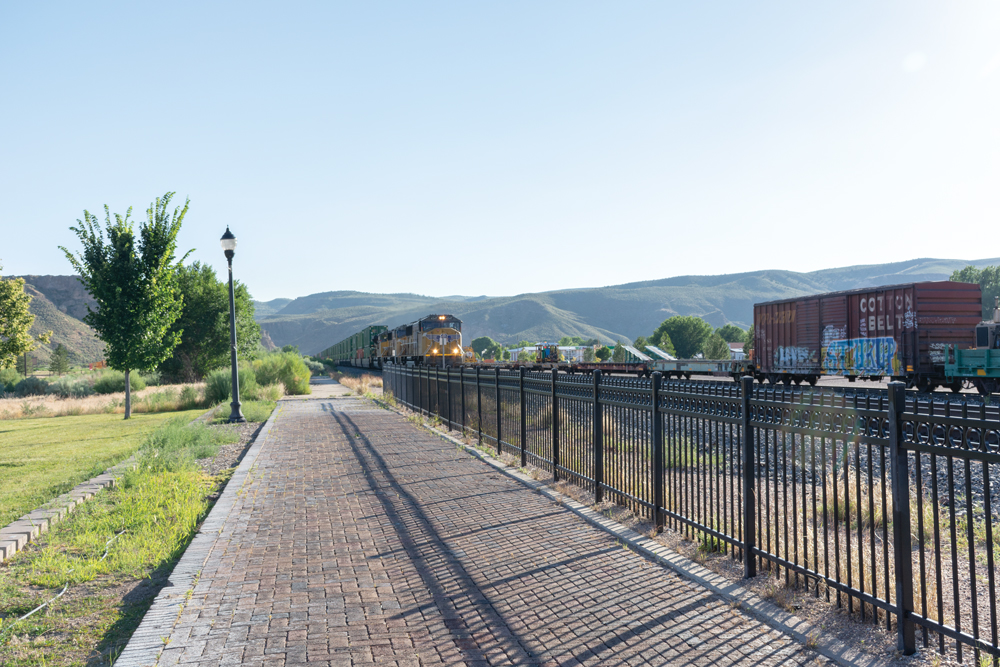
A person with true grit is often defined as someone who sticks to their goals, despite problems, setbacks, and failures. Having true grit means you are tough and determined…you have a steadfast core. In 2019, we are highlighting towns in Nevada that have that core strength. Not all towns in Nevada have huge shiny tourist draws; many exist along the highways that traverse our state but aside from getting gas or grabbing food to go, they are easily overlooked. Nevada roads go on forever. Small towns appear on the horizon, but are often quickly in the rearview mirror with little more than a passing thought about the town’s existence. And while tourism is the state’s largest industry—and the focus of this magazine—it is not why all towns in Nevada exist. This year, we honor some of those towns that defy easy description but stand tall in the desert, refusing to give into the sways of economic hardship or the passing of time. These towns bloom in the dirt, and they embody true grit. This issue: Caliente.

Zane Grey wrote that toward the end of his life. The prolific Western author was reportedly waxing poetic about the future, but given that the Conaway Ranch in Caliente was a favorite writing spot of his, it’s easy to believe he was speaking of the permanence of nature’s beauty in this southeastern Nevada town.
Tucked along the north-south route of U.S. Route 93, close to Utah but still firmly in Nevada, Caliente is a surprising find on what can be a lonely road. It is no surprise, however, that settlers found this lush landscape tucked amid rugged canyons and sweeping mountain ranges and decided to call it home.
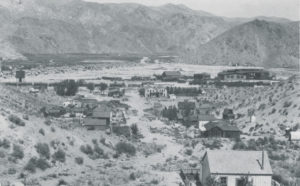 LIVING OFF THE LAND, AT FIRST
LIVING OFF THE LAND, AT FIRST
The first settlers of the meadow were ranchers and farmers, taking advantage of the creek that fostered towering cottonwood trees and the natural hot springs in the area as early as the 1860s. The area was known as Dutchman Flat, and then Culverwell, after the Culverwell brothers who provided hay from their ranch to nearby mining operations. For close to three decades, dairies, orchards, and lush farmlands defined the Meadow Wash Valley where Culverwell was located. But progress was about to arrive, along with the town’s future.
The Transcontinental Railroad crossed the U.S. in 1869, and the need for a north-south line between Los Angeles and Salt Lake City would soon become apparent. Railroad executive E.H. Harriman of the Union Pacific and Oregon Short Line recognized the windfall of sharing the West’s agricultural and mining boons with the East and in 1899, began building a line from Utah toward Culverwell. However, mining magnate William Clark began his own line, the San Pedro, Los Angeles and Salt Lake Railroad and the two raced toward southern Nevada, each determined to build his railway first.
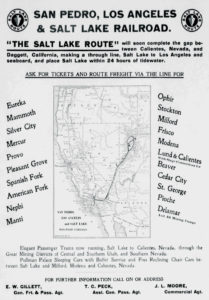
The canyons surrounding the Meadow Wash Valley and Culverwell were also determined; only one railway would have sufficient room to navigate the canyon. Clark and Harriman waged a brief railroad war of political posturing and downright skullduggery: it’s said one line would lay track by day while the other would pull up the tracks each night. Local legend has it one of the Culverwell brothers, William, had had enough of the fighting and using a two-barrel shotgun, convinced Clark and Harriman to come to an agreement, which they did.
RIDING THE RAILS
The newly-christened town of Caliente—named for the area hot springs—saw its first train in 1901, and the north-south line was completed in 1905. Caliente was the largest town in Lincoln County by 1910 with almost 1,800 residents, 47 saloons, two hotels, and four barber shops.
The railroad continued to be the major employer of Caliente until the 1940s, when the division point was moved to Las Vegas. The population dwindled as residents followed the railroad jobs, and today, Caliente is home to about 1,100 people. Union Pacific still runs freight trains through town and past the 1923 Mission-style depot, but while it’s still a big employer, the town has had to move on.
“We’ve kind of converted away from the railroad. Once, 90 percent of our people were working there, but it’s more automated now, so that’s changed,” Caliente Mayor Steve Rowe explains.
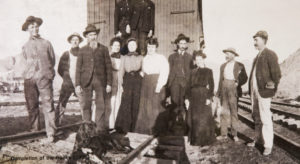
Steve grew up in Caliente—a lifer, as he puts it—and his family has been in the area since the 1880s. He’s seen the town change over the years and its focus shift to different enterprises, but there’s one thing that’s never changed, and that’s how much he loves Caliente.
“It’s beautiful and charming,” he says. “I grew up hunting and fishing and running around in the hills. I still see deer in my backyard, and I can still take a drive and not see anybody for hours.”
The area’s beauty and outdoor offerings are not lost on the town’s residents, and Steve says while the Caliente Youth Center, the Nevada Test Site, and the railroad are all important employers, tourists may be a key to the town’s future.
“We’re definitely working to bring in more tourists,” Steve says.
RIDING THE TRAILS
Lincoln County is home to five state parks, all within a 50-mile radius of one another and all within an hour of Caliente. Seemingly endless trails run along the ridges and through the hills surrounding the town, lending themselves to off-road adventures, both motorized and human-powered. The scenery changes from red clay to white volcanic ash cones to pine forests, leaving no wonder why the area is already a popular ATV and UTV destination with annual races like the Knotty Pine 250, among others.
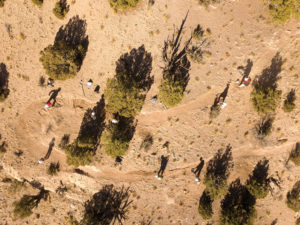
“It’s an amazing place for desert racing,” according to resident and business owner Dana Lee Freund.
Dana moved back to Caliente recently, something she and her husband always planned on. They opened a couple businesses in town, including a bike shop, and she immediately noticed a difference after her 10-year absence.
“There are so many people from foreign countries coming through here,” she notes. “Some are traveling from Zion, Utah to Vegas, or coming from Vegas to do the trails, or having a daycation. They are bringing friends from California who are bringing friends from Brazil. We’ve had people from France, Spain, Croatia, Japan, Germany, and Switzerland coming here to ride in the state parks.”
While Dana was away, the mountain bike community discovered Caliente. About 2012, the local chapter of the International Mountain Bicycling Association (IMBA) began sharing the word about the area’s potential. The land surrounding the town was ripe with trail possibilities and in 2017 trail building was underway. According to the IMBA website, 43 miles of trails, from “beginner-rated, introductory flow trails to rocky, technical, mountain-bike only singletrack (some of it directional)” have been designed.
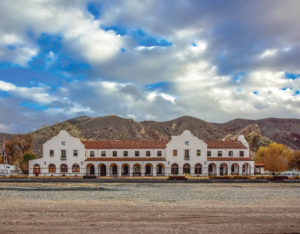
“By this fall, some 20-plus miles will be ready,” Steve says. “We have a pump track that’s part of one of the parks now, and the trailhead is right at the park, too.”
Steve notes the community has been behind the development of Caliente as a mountain bike destination, but he also knows that in order to have bike tourism as a viable economic driver, the trails will need to be maintained.
“It could be a problem, but we want to keep them in top shape and we’re working with volunteer groups,” he says.
CHICKEN OR THE EGG
The Catch-22 for Caliente—as it is for many small towns—is that in order to attract people to things like mountain biking opportunities, you have to have the infrastructure to support tourist visits.
“We could use more hotels, it’s true,” Dana admits. “That’s always been our downfall because we can’t host larger events. But we have the infrastructure. We have a new restaurant, Side Tracks, and there’s pizza and craft beer, and we have a mobile coffee shop. People are stopping here to ride.”
As the community moves toward increasing its tourism appeal, other options are still being looked at. Steve mentions there are grow facilities being built for the marijuana industry that he hopes will bring in some tax revenue. Dana mentions there are people moving into Caliente and buying closed businesses, plus there’s property development happening that could be a resort in the near future. Like most people who live in small towns, the question about do they want to see growth is met with a resounding yes, but with caveats.
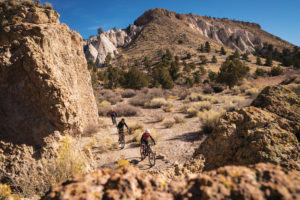
“Tourism is a big future. I don’t want to see huge growth, but definitely growth is needed, and tourism is perfect,” Dana says. “People come and then they leave. I see tourism enhancing our life here in a good way. I run a social media magazine here in Lincoln county and it has all our local events and it’s shared all over the place. We say, ‘Come to Caliente; the secret is out.’”
As Caliente continues to diversify its future strategies and focus on tourism as a means of economic viability, Steve echoes the need to get the word out about what the town has to offer. Lincoln County and Caliente are working on advertising and getting the word out, which he believes is key to his town’s success.

